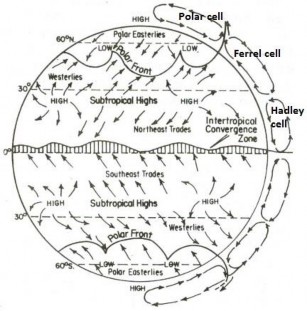4.7.1. Planetary Winds
Primary or planetary winds blow from high pressure belts to low pressure belts in the same direction throughout the year. They blow over vast area of continents and oceans. Trade winds, Westerlies and polar easterlies together form the planetary wind circulation (figure 18). These are described below:
♤ The air at the Inter Tropical Convergence Zone (ITCZ) rises because of convection caused by high insolation and a low pressure is created. The winds from the tropics converge at this low pressure zone. The converged air rises along up. It reaches the top of the troposphere up to an altitude of 14 km. and moves towards the poles. This causes accumulation of air at about 300 N and S. Part of the accumulated air sinks to the ground and forms a subtropical high. Another reason for sinking is the cooling of air when it reaches 300 N and S latitudes. Down below near the land surface the air flows towards the equator as the easterlies1 or tropical easterlies or trade winds. Because of Coriolis force, their direction becomes north-east and south-east in northern and southern hemisphere respectively. The easterlies from either side of the equator converge in the Inter Tropical Convergence Zone (ITCZ). Thus, winds originated at ITCZ come back in a circular fashion. Such a cell in the tropics is called Hadley Cell.
♤ In the middle latitudes (300-600) the circulation is that of sinking cold air that comes from the poles and the rising warm air that blows from the subtropical high pressure belt. These winds are deflected due to coriolis force and become westerly in both the hemisphere. Deflected wind is called westerlies. These winds meet along the sub-polar low pressure belt to raise high in the troposphere. From here, air moves away in both directions – towards pole and equator. These winds start descending down above the sup-tropical high pressure belt and polar high pressure belt to form cells. These cells are called Ferrel cell and Polar cell respectively.

1 Wind direction is reported by the direction from which it originates. For example, a easterly wind blows from the east to the west.

